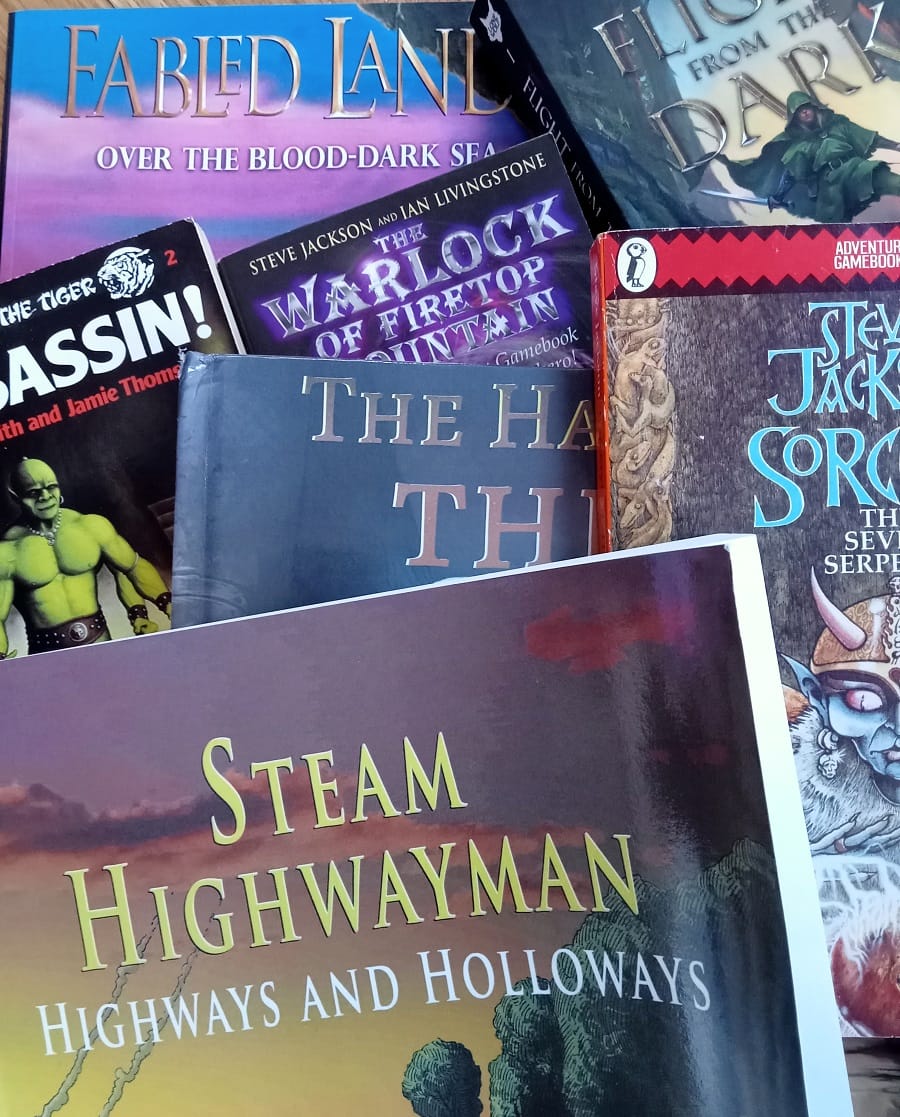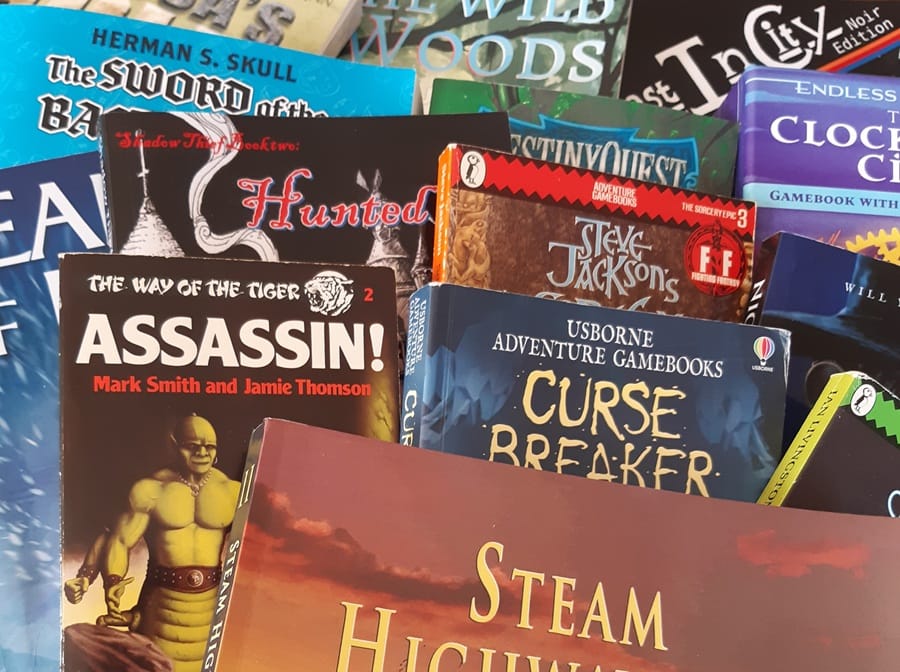Looking at how encounter tables can be used in a positive way in an open-world gamebook.
Encounter Tables Basics
The first Wandering Monster I remember from a gamebook is in the Warlock of Firetop Mountain, where there are several places in the Maze of Zagor you might encounter something. You're told to go to the wandering monsters table and given a reference to return to later.
| 1d6 | Creature | SKILL | STAMINA |
|---|---|---|---|
| 1 | GOBLIN | 5 | 3 |
| 2 | ORC | 6 | 3 |
| 3 | GREMLIN | 6 | 4 |
| 4 | GIANT RAT | 5 | 4 |
| 5 | SKELETON | 6 | 5 |
| 6 | TROLL | 8 | 4 |
This table mainly gives you something to fight in the maze, and showing how wimpy the monsters of the maze are! Maybe they're starved or injured?
It's adding uncertainty to the maze experience, showing off what creatures can be expected in the maze and making you think about exploring too much, in case you attract more.
Although if your character has got this far into Firetop Mountain, none of these creatures are likely to challenge your adventurer.
Improving Encounter Tables
Encounter tables can be used for lots more than a fight with a single creature. This is one area I actually do know something, as I've published many encounter titles for RPGs, System Neutral and for D&D 5E
In a gamebook, they can...
- Provide information about the world and the area the character(s) are currently in. This could be creature types, someone with a rumour, villagers telling a story, or tracks of a huge creature, active in the area.
- Introduce NPCs. These might react differently, keyed by tickboxes, codewords and titles. A bounty hunter may ask you for information on their current target. But depending in your previous actions, they might offer to team up with you for a quest, offer you some information, avoid you, or even hunt you down for the bounty on your character's head. Ill cover Wandering NPCs in a future Gamebook Diary.
- Trigger Events. It might be the first snows of winter, the horns of a fey hunt, finding some interesting mushrooms, or coming across a riderless pony.
- Show when an area is dangerous, maybe even beyond the current capability of a character, if it's that kind of gamebook
- Showing unique encounters. Coming from a list of unique encounters, each of which can only be triggered once.
- Adding Variety and Uncertainty. This is a big one for me, as if written well, the encounters can add to the feeling of danger and excitement to an area. But it can also be repetitive if the character has to fight the same pair of goblins for the twelfth time.
Using Encounters As a Cost
In the first Fabled Lands book, there are some areas where there are encounters, but simple tables with maybe 3 results. Like finding a fish, fighting a wolf or finding a coin on the road.
As only a few regions had these encounters, and many didn't, you could plot a course from one town to the next with no danger. Considering this was often crossing half a kingdom, it could be kind of underwhelming.
One thing I'm planning on doing is having an encounter roll every time a new region is entered. This means that any journey has uncertainty and a potential cost.
The roleplaying game Knave 2nd Edition does something like this, having a d6 table for every 4 hours. when traveling. This table has 1 - Encounter, 2 - Fatigue, 3 - Depletion (of resources), 4 - Weather or local event, 5 - Sign (of an encounter), 6 - Nothing
This keeps up a constant touch of uncertainty, that the world is a living place. It's too much for a gamebook, but you could easily find encounters, weather and possible depletion of resources in an encounter table for an open-world RPG.
So if entering the farming area of Westwood Hamlets it might be
| 1d6 | Encounter |
|---|---|
| 1 | A farmer invites you in for a meal. You spend a pleasant evening with them and sleep in their barn, amidst the smell of cows. They also pass on a rumour, turn to 101 |
| 2 | A number of magpies flies near you. Roll a die, if it's a 3, increase OMENS by 1. Otherwise, restore 1 LUCK. Then, if you have keyword Hunted turn to 543 |
| 3 | You are followed by a stray pig. If you wish, you may adopt a stray pig. If you have the talent Survival, you may instead kill it and turn it into two rations |
| 4 | You meat a pair of villagers selling pies and cider. For 1 sp you may buy a meat pie and also for 1 sp they will give you some cider to drink. If you drink the cider, turn to 123 |
| 5 | [] If this tickbox is ticked, turn to 88. Otherwise, tick it and turn to 266. |
| 6 | You encounter a wanderer. Turn to 405 to see who it is |
None of these are obviously dangerous, which is fitting with an area of farmlands. They demonstrate who you might expect with farmers and animals. Plus it's a civilised area, so you might meet a wandering NPC, with many branching possibilities.
Another use of these encounter tables is as a cost for taking lots of time or attracting attention.
Fail that check to forage in woods? an Encounter.
A Success? No encounter and you find some strange mushrooms.
A Partial Success? You find those mushrooms, but also have an encounter.
Not every Village needs an Encounter Table
However, not every village needs an encounter table, and this would get tedious quickly.
However, in the above example of Westwood Hamlets, this is an area containing multiple sites. So it has the Village of Somersby, Doombar's Hamlet, Lower Beamish, Hobgoblin Hill and the Boddington Ruins. Each is a location with it's own characters and leads to investigate.
Going between these areas won't normally trigger an encounter table, but when entering the area of Westwood Hamlets you will. If an area is dangerous, such as Boddington Ruins, then that might also have it's own encounter table. And if you're at Hobgoblin Hill at night, who knows what you might meet...
There might also be codewords or other conditions that trigger more encounters or possibility of encounters. If there are raiders haunting the area, or people are looking for you because of that fat bounty on your head...
Towns can function similarly, with an encounter table when entering or wandering the streets, but not when going between each locations. This could be NPCs, weather, unique events, a patrol of guards, a subtable of local crime or local flavour.
Avoiding the Encounters
It's also useful to have a way to avoid encounters, as a way of rewarding players for exploring, being more experienced.
It could be a portal that takes them between locations, a guide who can avoid trouble in a particular location. They could pay for safe passage in a caravan between two towns, or passage on a riverboat going downstream.
Some players will want encounters at every opportunity, and others will prefer to spend a little money to avoid them when they can.
More Encounters
I'm still working out all the details for my encounters, on where the sweet spot is between too many and just enough.
We haven't yet talked about encounter subtables, more difficult encounters later in the game (on the same table), or waiting for particular encounters (like the ambushing of targets in Steam Highwayman).
And wandering NPCs is a whole different topic, one for a future Gamebook Diary!
Finishing Up
Using encounter tables to differentiate regions and for game flow could be a great thing, or a disaster that most players hate.
Only time will tell, and the publishing of the first gamebook!



